Report on Business Environment Analysis for Techcombank Vietnam
VerifiedAdded on 2021/11/23
|26
|8739
|87
Report
AI Summary
This report analyzes the business environment of Techcombank, a major bank in Vietnam, as of 2020. The analysis begins with an introduction discussing the impact of global events on the Vietnamese banking sector. It then applies Porter's 5 Forces to assess the competitive landscape of the banking industry, examining the threat of new entrants, bargaining power of suppliers and buyers, the threat of substitutes, and rivalry among competitors. A PESTLE analysis is conducted to evaluate the political/legal, economic, sociological, technological factors influencing Techcombank. The report also utilizes a SWOT analysis to evaluate the bank's internal strengths and weaknesses in relation to external opportunities and threats, proposing strategic recommendations. The report concludes with a summary of findings and references to relevant sources.
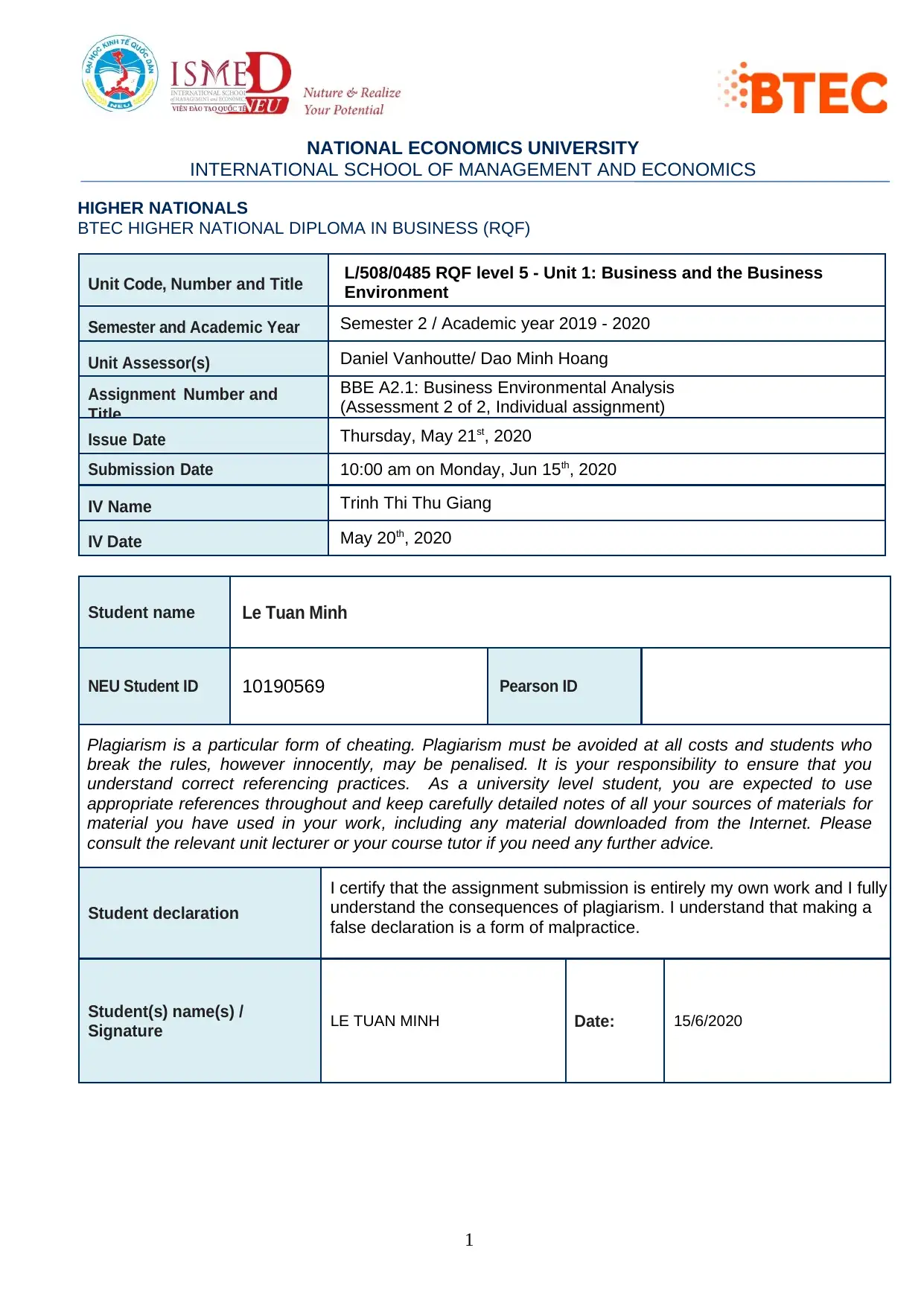
NATIONAL ECONOMICS UNIVERSITY
INTERNATIONAL SCHOOL OF MANAGEMENT AND ECONOMICS
HIGHER NATIONALS
BTEC HIGHER NATIONAL DIPLOMA IN BUSINESS (RQF)
Unit Code, Number and Title L/508/0485 RQF level 5 - Unit 1: Business and the Business
Environment
Semester and Academic Year Semester 2 / Academic year 2019 - 2020
Unit Assessor(s) Daniel Vanhoutte/ Dao Minh Hoang
Assignment Number and
Title
BBE A2.1: Business Environmental Analysis
(Assessment 2 of 2, Individual assignment)
Issue Date Thursday, May 21st, 2020
Submission Date 10:00 am on Monday, Jun 15th, 2020
IV Name Trinh Thi Thu Giang
IV Date May 20th, 2020
Student name Le Tuan Minh
NEU Student ID 10190569 Pearson ID
Plagiarism is a particular form of cheating. Plagiarism must be avoided at all costs and students who
break the rules, however innocently, may be penalised. It is your responsibility to ensure that you
understand correct referencing practices. As a university level student, you are expected to use
appropriate references throughout and keep carefully detailed notes of all your sources of materials for
material you have used in your work, including any material downloaded from the Internet. Please
consult the relevant unit lecturer or your course tutor if you need any further advice.
Student declaration
I certify that the assignment submission is entirely my own work and I fully
understand the consequences of plagiarism. I understand that making a
false declaration is a form of malpractice.
Student(s) name(s) /
Signature LE TUAN MINH Date: 15/6/2020
1
INTERNATIONAL SCHOOL OF MANAGEMENT AND ECONOMICS
HIGHER NATIONALS
BTEC HIGHER NATIONAL DIPLOMA IN BUSINESS (RQF)
Unit Code, Number and Title L/508/0485 RQF level 5 - Unit 1: Business and the Business
Environment
Semester and Academic Year Semester 2 / Academic year 2019 - 2020
Unit Assessor(s) Daniel Vanhoutte/ Dao Minh Hoang
Assignment Number and
Title
BBE A2.1: Business Environmental Analysis
(Assessment 2 of 2, Individual assignment)
Issue Date Thursday, May 21st, 2020
Submission Date 10:00 am on Monday, Jun 15th, 2020
IV Name Trinh Thi Thu Giang
IV Date May 20th, 2020
Student name Le Tuan Minh
NEU Student ID 10190569 Pearson ID
Plagiarism is a particular form of cheating. Plagiarism must be avoided at all costs and students who
break the rules, however innocently, may be penalised. It is your responsibility to ensure that you
understand correct referencing practices. As a university level student, you are expected to use
appropriate references throughout and keep carefully detailed notes of all your sources of materials for
material you have used in your work, including any material downloaded from the Internet. Please
consult the relevant unit lecturer or your course tutor if you need any further advice.
Student declaration
I certify that the assignment submission is entirely my own work and I fully
understand the consequences of plagiarism. I understand that making a
false declaration is a form of malpractice.
Student(s) name(s) /
Signature LE TUAN MINH Date: 15/6/2020
1
Paraphrase This Document
Need a fresh take? Get an instant paraphrase of this document with our AI Paraphraser
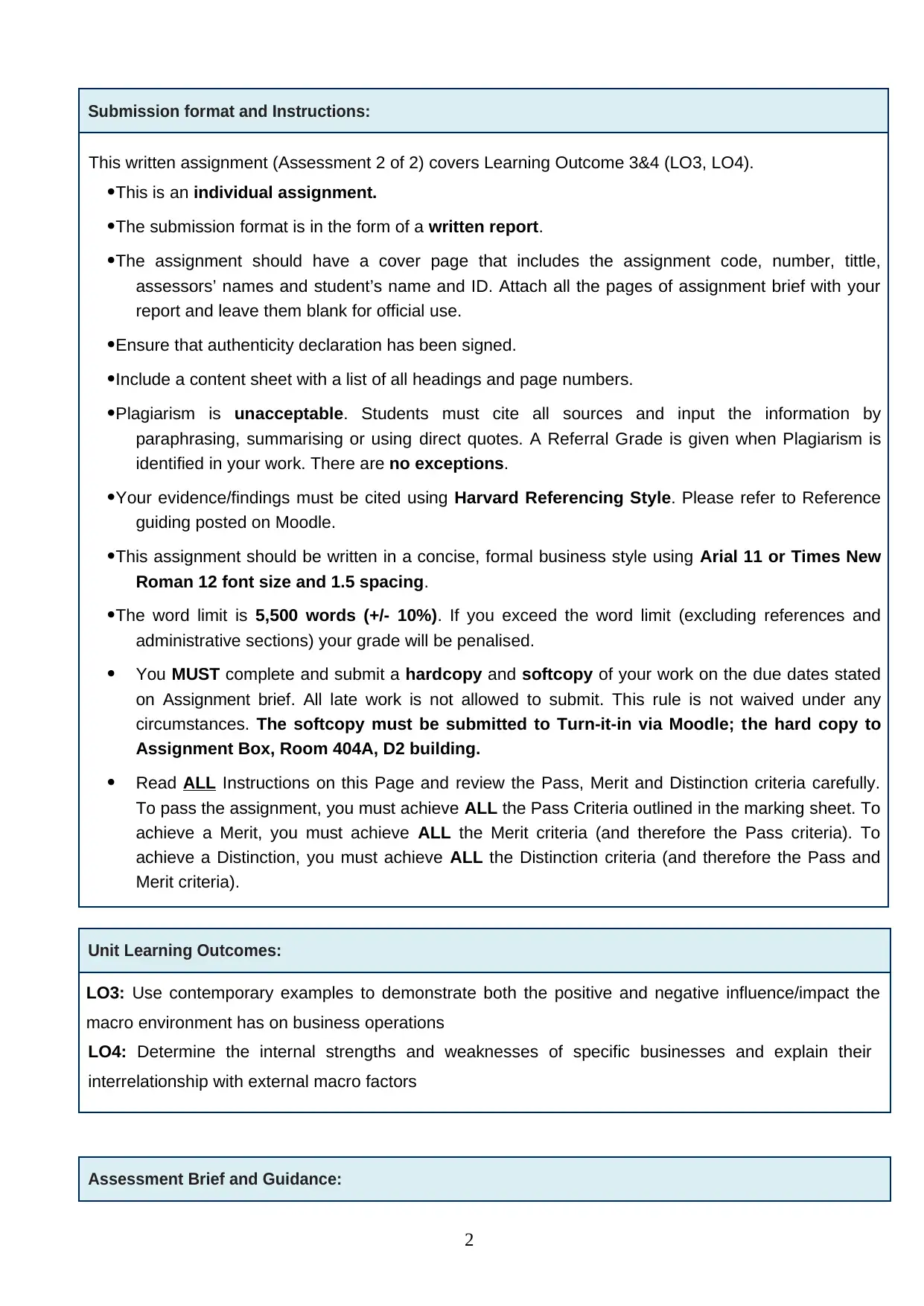
Submission format and Instructions:
This written assignment (Assessment 2 of 2) covers Learning Outcome 3&4 (LO3, LO4).
This is an individual assignment.
The submission format is in the form of a written report.
The assignment should have a cover page that includes the assignment code, number, tittle,
assessors’ names and student’s name and ID. Attach all the pages of assignment brief with your
report and leave them blank for official use.
Ensure that authenticity declaration has been signed.
Include a content sheet with a list of all headings and page numbers.
Plagiarism is unacceptable. Students must cite all sources and input the information by
paraphrasing, summarising or using direct quotes. A Referral Grade is given when Plagiarism is
identified in your work. There are no exceptions.
Your evidence/findings must be cited using Harvard Referencing Style. Please refer to Reference
guiding posted on Moodle.
This assignment should be written in a concise, formal business style using Arial 11 or Times New
Roman 12 font size and 1.5 spacing.
The word limit is 5,500 words (+/- 10%). If you exceed the word limit (excluding references and
administrative sections) your grade will be penalised.
You MUST complete and submit a hardcopy and softcopy of your work on the due dates stated
on Assignment brief. All late work is not allowed to submit. This rule is not waived under any
circumstances. The softcopy must be submitted to Turn-it-in via Moodle; the hard copy to
Assignment Box, Room 404A, D2 building.
Read ALL Instructions on this Page and review the Pass, Merit and Distinction criteria carefully.
To pass the assignment, you must achieve ALL the Pass Criteria outlined in the marking sheet. To
achieve a Merit, you must achieve ALL the Merit criteria (and therefore the Pass criteria). To
achieve a Distinction, you must achieve ALL the Distinction criteria (and therefore the Pass and
Merit criteria).
Unit Learning Outcomes:
LO3: Use contemporary examples to demonstrate both the positive and negative influence/impact the
macro environment has on business operations
LO4: Determine the internal strengths and weaknesses of specific businesses and explain their
interrelationship with external macro factors
Assessment Brief and Guidance:
2
This written assignment (Assessment 2 of 2) covers Learning Outcome 3&4 (LO3, LO4).
This is an individual assignment.
The submission format is in the form of a written report.
The assignment should have a cover page that includes the assignment code, number, tittle,
assessors’ names and student’s name and ID. Attach all the pages of assignment brief with your
report and leave them blank for official use.
Ensure that authenticity declaration has been signed.
Include a content sheet with a list of all headings and page numbers.
Plagiarism is unacceptable. Students must cite all sources and input the information by
paraphrasing, summarising or using direct quotes. A Referral Grade is given when Plagiarism is
identified in your work. There are no exceptions.
Your evidence/findings must be cited using Harvard Referencing Style. Please refer to Reference
guiding posted on Moodle.
This assignment should be written in a concise, formal business style using Arial 11 or Times New
Roman 12 font size and 1.5 spacing.
The word limit is 5,500 words (+/- 10%). If you exceed the word limit (excluding references and
administrative sections) your grade will be penalised.
You MUST complete and submit a hardcopy and softcopy of your work on the due dates stated
on Assignment brief. All late work is not allowed to submit. This rule is not waived under any
circumstances. The softcopy must be submitted to Turn-it-in via Moodle; the hard copy to
Assignment Box, Room 404A, D2 building.
Read ALL Instructions on this Page and review the Pass, Merit and Distinction criteria carefully.
To pass the assignment, you must achieve ALL the Pass Criteria outlined in the marking sheet. To
achieve a Merit, you must achieve ALL the Merit criteria (and therefore the Pass criteria). To
achieve a Distinction, you must achieve ALL the Distinction criteria (and therefore the Pass and
Merit criteria).
Unit Learning Outcomes:
LO3: Use contemporary examples to demonstrate both the positive and negative influence/impact the
macro environment has on business operations
LO4: Determine the internal strengths and weaknesses of specific businesses and explain their
interrelationship with external macro factors
Assessment Brief and Guidance:
2
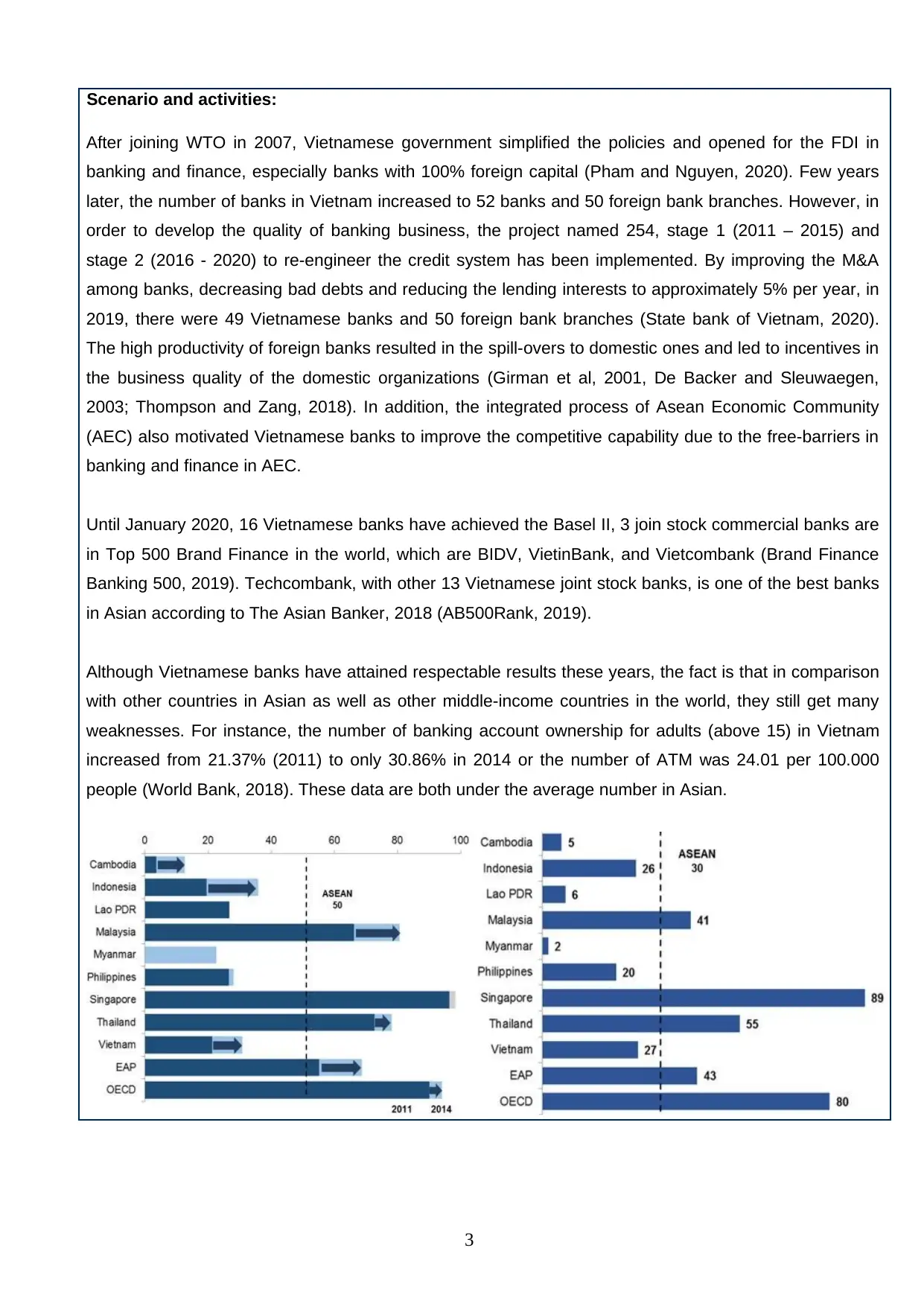
Scenario and activities:
After joining WTO in 2007, Vietnamese government simplified the policies and opened for the FDI in
banking and finance, especially banks with 100% foreign capital (Pham and Nguyen, 2020). Few years
later, the number of banks in Vietnam increased to 52 banks and 50 foreign bank branches. However, in
order to develop the quality of banking business, the project named 254, stage 1 (2011 – 2015) and
stage 2 (2016 - 2020) to re-engineer the credit system has been implemented. By improving the M&A
among banks, decreasing bad debts and reducing the lending interests to approximately 5% per year, in
2019, there were 49 Vietnamese banks and 50 foreign bank branches (State bank of Vietnam, 2020).
The high productivity of foreign banks resulted in the spill-overs to domestic ones and led to incentives in
the business quality of the domestic organizations (Girman et al, 2001, De Backer and Sleuwaegen,
2003; Thompson and Zang, 2018). In addition, the integrated process of Asean Economic Community
(AEC) also motivated Vietnamese banks to improve the competitive capability due to the free-barriers in
banking and finance in AEC.
Until January 2020, 16 Vietnamese banks have achieved the Basel II, 3 join stock commercial banks are
in Top 500 Brand Finance in the world, which are BIDV, VietinBank, and Vietcombank (Brand Finance
Banking 500, 2019). Techcombank, with other 13 Vietnamese joint stock banks, is one of the best banks
in Asian according to The Asian Banker, 2018 (AB500Rank, 2019).
Although Vietnamese banks have attained respectable results these years, the fact is that in comparison
with other countries in Asian as well as other middle-income countries in the world, they still get many
weaknesses. For instance, the number of banking account ownership for adults (above 15) in Vietnam
increased from 21.37% (2011) to only 30.86% in 2014 or the number of ATM was 24.01 per 100.000
people (World Bank, 2018). These data are both under the average number in Asian.
3
After joining WTO in 2007, Vietnamese government simplified the policies and opened for the FDI in
banking and finance, especially banks with 100% foreign capital (Pham and Nguyen, 2020). Few years
later, the number of banks in Vietnam increased to 52 banks and 50 foreign bank branches. However, in
order to develop the quality of banking business, the project named 254, stage 1 (2011 – 2015) and
stage 2 (2016 - 2020) to re-engineer the credit system has been implemented. By improving the M&A
among banks, decreasing bad debts and reducing the lending interests to approximately 5% per year, in
2019, there were 49 Vietnamese banks and 50 foreign bank branches (State bank of Vietnam, 2020).
The high productivity of foreign banks resulted in the spill-overs to domestic ones and led to incentives in
the business quality of the domestic organizations (Girman et al, 2001, De Backer and Sleuwaegen,
2003; Thompson and Zang, 2018). In addition, the integrated process of Asean Economic Community
(AEC) also motivated Vietnamese banks to improve the competitive capability due to the free-barriers in
banking and finance in AEC.
Until January 2020, 16 Vietnamese banks have achieved the Basel II, 3 join stock commercial banks are
in Top 500 Brand Finance in the world, which are BIDV, VietinBank, and Vietcombank (Brand Finance
Banking 500, 2019). Techcombank, with other 13 Vietnamese joint stock banks, is one of the best banks
in Asian according to The Asian Banker, 2018 (AB500Rank, 2019).
Although Vietnamese banks have attained respectable results these years, the fact is that in comparison
with other countries in Asian as well as other middle-income countries in the world, they still get many
weaknesses. For instance, the number of banking account ownership for adults (above 15) in Vietnam
increased from 21.37% (2011) to only 30.86% in 2014 or the number of ATM was 24.01 per 100.000
people (World Bank, 2018). These data are both under the average number in Asian.
3
⊘ This is a preview!⊘
Do you want full access?
Subscribe today to unlock all pages.

Trusted by 1+ million students worldwide
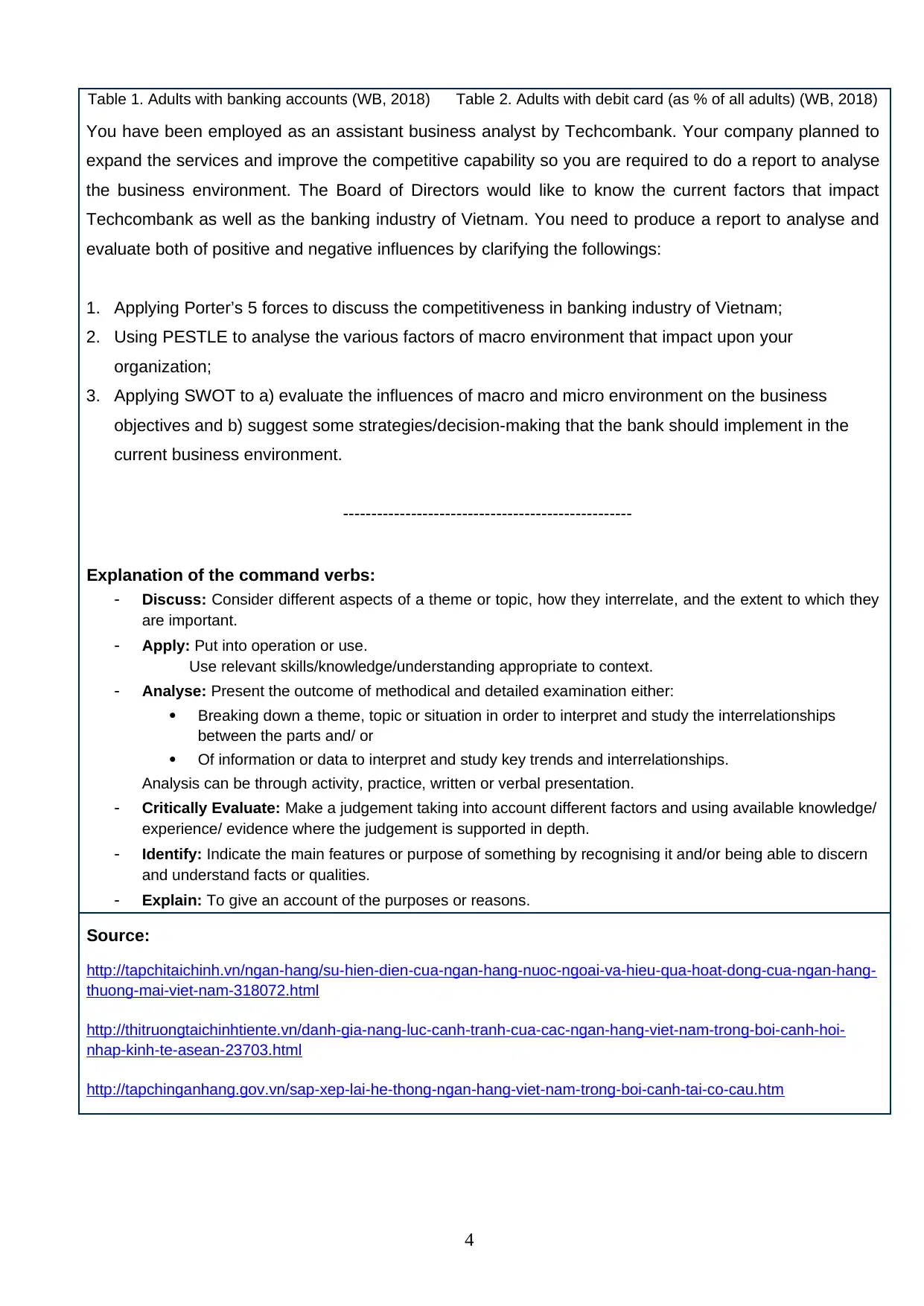
Table 1. Adults with banking accounts (WB, 2018) Table 2. Adults with debit card (as % of all adults) (WB, 2018)
You have been employed as an assistant business analyst by Techcombank. Your company planned to
expand the services and improve the competitive capability so you are required to do a report to analyse
the business environment. The Board of Directors would like to know the current factors that impact
Techcombank as well as the banking industry of Vietnam. You need to produce a report to analyse and
evaluate both of positive and negative influences by clarifying the followings:
1. Applying Porter’s 5 forces to discuss the competitiveness in banking industry of Vietnam;
2. Using PESTLE to analyse the various factors of macro environment that impact upon your
organization;
3. Applying SWOT to a) evaluate the influences of macro and micro environment on the business
objectives and b) suggest some strategies/decision-making that the bank should implement in the
current business environment.
---------------------------------------------------
Explanation of the command verbs:
- Discuss: Consider different aspects of a theme or topic, how they interrelate, and the extent to which they
are important.
- Apply: Put into operation or use.
Use relevant skills/knowledge/understanding appropriate to context.
- Analyse: Present the outcome of methodical and detailed examination either:
Breaking down a theme, topic or situation in order to interpret and study the interrelationships
between the parts and/ or
Of information or data to interpret and study key trends and interrelationships.
Analysis can be through activity, practice, written or verbal presentation.
- Critically Evaluate: Make a judgement taking into account different factors and using available knowledge/
experience/ evidence where the judgement is supported in depth.
- Identify: Indicate the main features or purpose of something by recognising it and/or being able to discern
and understand facts or qualities.
- Explain: To give an account of the purposes or reasons.
Source:
http://tapchitaichinh.vn/ngan-hang/su-hien-dien-cua-ngan-hang-nuoc-ngoai-va-hieu-qua-hoat-dong-cua-ngan-hang-
thuong-mai-viet-nam-318072.html
http://thitruongtaichinhtiente.vn/danh-gia-nang-luc-canh-tranh-cua-cac-ngan-hang-viet-nam-trong-boi-canh-hoi-
nhap-kinh-te-asean-23703.html
http://tapchinganhang.gov.vn/sap-xep-lai-he-thong-ngan-hang-viet-nam-trong-boi-canh-tai-co-cau.htm
4
You have been employed as an assistant business analyst by Techcombank. Your company planned to
expand the services and improve the competitive capability so you are required to do a report to analyse
the business environment. The Board of Directors would like to know the current factors that impact
Techcombank as well as the banking industry of Vietnam. You need to produce a report to analyse and
evaluate both of positive and negative influences by clarifying the followings:
1. Applying Porter’s 5 forces to discuss the competitiveness in banking industry of Vietnam;
2. Using PESTLE to analyse the various factors of macro environment that impact upon your
organization;
3. Applying SWOT to a) evaluate the influences of macro and micro environment on the business
objectives and b) suggest some strategies/decision-making that the bank should implement in the
current business environment.
---------------------------------------------------
Explanation of the command verbs:
- Discuss: Consider different aspects of a theme or topic, how they interrelate, and the extent to which they
are important.
- Apply: Put into operation or use.
Use relevant skills/knowledge/understanding appropriate to context.
- Analyse: Present the outcome of methodical and detailed examination either:
Breaking down a theme, topic or situation in order to interpret and study the interrelationships
between the parts and/ or
Of information or data to interpret and study key trends and interrelationships.
Analysis can be through activity, practice, written or verbal presentation.
- Critically Evaluate: Make a judgement taking into account different factors and using available knowledge/
experience/ evidence where the judgement is supported in depth.
- Identify: Indicate the main features or purpose of something by recognising it and/or being able to discern
and understand facts or qualities.
- Explain: To give an account of the purposes or reasons.
Source:
http://tapchitaichinh.vn/ngan-hang/su-hien-dien-cua-ngan-hang-nuoc-ngoai-va-hieu-qua-hoat-dong-cua-ngan-hang-
thuong-mai-viet-nam-318072.html
http://thitruongtaichinhtiente.vn/danh-gia-nang-luc-canh-tranh-cua-cac-ngan-hang-viet-nam-trong-boi-canh-hoi-
nhap-kinh-te-asean-23703.html
http://tapchinganhang.gov.vn/sap-xep-lai-he-thong-ngan-hang-viet-nam-trong-boi-canh-tai-co-cau.htm
4
Paraphrase This Document
Need a fresh take? Get an instant paraphrase of this document with our AI Paraphraser
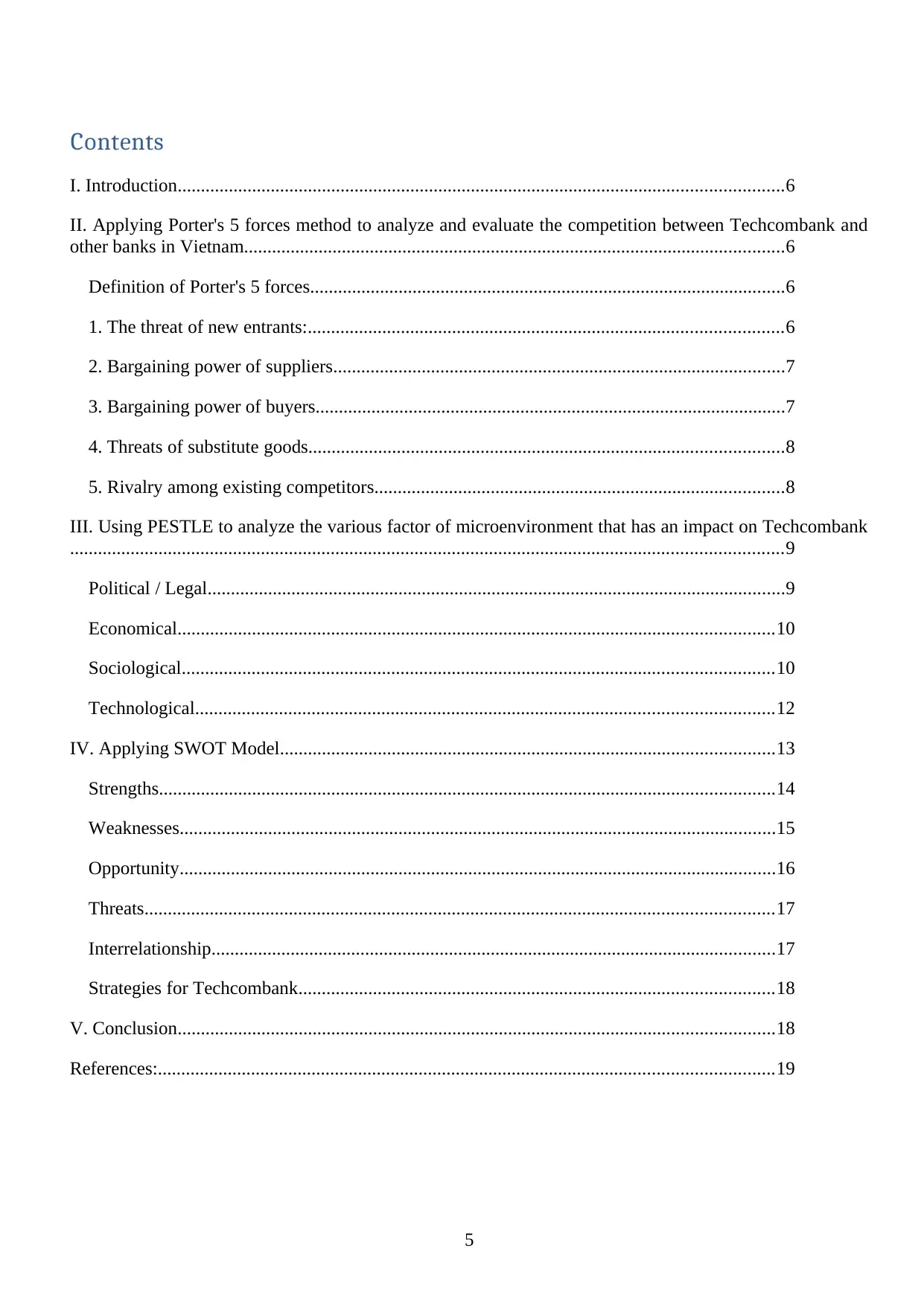
Contents
I. Introduction..................................................................................................................................6
II. Applying Porter's 5 forces method to analyze and evaluate the competition between Techcombank and
other banks in Vietnam....................................................................................................................6
Definition of Porter's 5 forces......................................................................................................6
1. The threat of new entrants:......................................................................................................6
2. Bargaining power of suppliers.................................................................................................7
3. Bargaining power of buyers.....................................................................................................7
4. Threats of substitute goods......................................................................................................8
5. Rivalry among existing competitors........................................................................................8
III. Using PESTLE to analyze the various factor of microenvironment that has an impact on Techcombank
.........................................................................................................................................................9
Political / Legal............................................................................................................................9
Economical................................................................................................................................10
Sociological...............................................................................................................................10
Technological............................................................................................................................12
IV. Applying SWOT Model..........................................................................................................13
Strengths....................................................................................................................................14
Weaknesses................................................................................................................................15
Opportunity................................................................................................................................16
Threats.......................................................................................................................................17
Interrelationship.........................................................................................................................17
Strategies for Techcombank......................................................................................................18
V. Conclusion................................................................................................................................18
References:....................................................................................................................................19
5
I. Introduction..................................................................................................................................6
II. Applying Porter's 5 forces method to analyze and evaluate the competition between Techcombank and
other banks in Vietnam....................................................................................................................6
Definition of Porter's 5 forces......................................................................................................6
1. The threat of new entrants:......................................................................................................6
2. Bargaining power of suppliers.................................................................................................7
3. Bargaining power of buyers.....................................................................................................7
4. Threats of substitute goods......................................................................................................8
5. Rivalry among existing competitors........................................................................................8
III. Using PESTLE to analyze the various factor of microenvironment that has an impact on Techcombank
.........................................................................................................................................................9
Political / Legal............................................................................................................................9
Economical................................................................................................................................10
Sociological...............................................................................................................................10
Technological............................................................................................................................12
IV. Applying SWOT Model..........................................................................................................13
Strengths....................................................................................................................................14
Weaknesses................................................................................................................................15
Opportunity................................................................................................................................16
Threats.......................................................................................................................................17
Interrelationship.........................................................................................................................17
Strategies for Techcombank......................................................................................................18
V. Conclusion................................................................................................................................18
References:....................................................................................................................................19
5
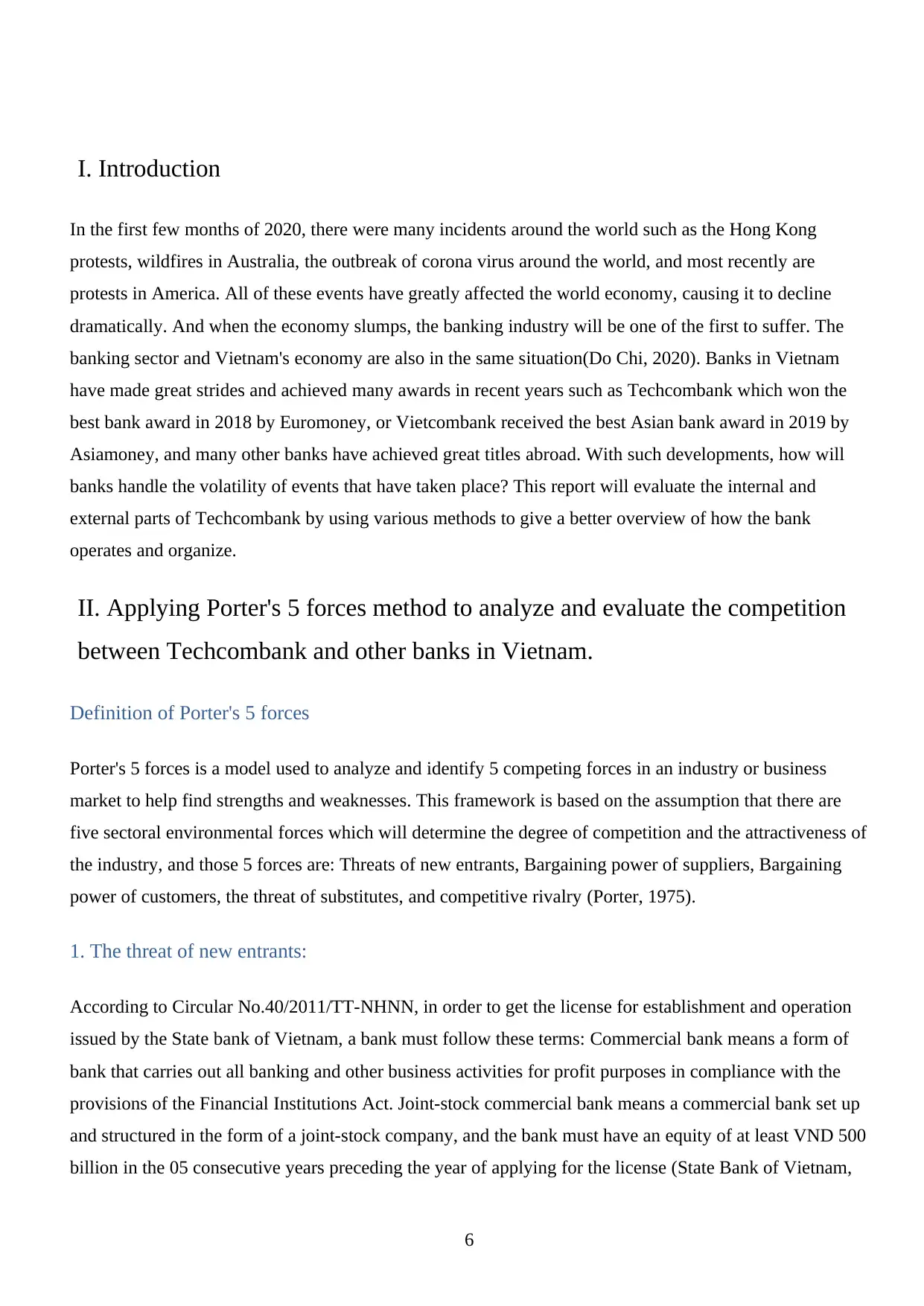
I. Introduction
In the first few months of 2020, there were many incidents around the world such as the Hong Kong
protests, wildfires in Australia, the outbreak of corona virus around the world, and most recently are
protests in America. All of these events have greatly affected the world economy, causing it to decline
dramatically. And when the economy slumps, the banking industry will be one of the first to suffer. The
banking sector and Vietnam's economy are also in the same situation(Do Chi, 2020). Banks in Vietnam
have made great strides and achieved many awards in recent years such as Techcombank which won the
best bank award in 2018 by Euromoney, or Vietcombank received the best Asian bank award in 2019 by
Asiamoney, and many other banks have achieved great titles abroad. With such developments, how will
banks handle the volatility of events that have taken place? This report will evaluate the internal and
external parts of Techcombank by using various methods to give a better overview of how the bank
operates and organize.
II. Applying Porter's 5 forces method to analyze and evaluate the competition
between Techcombank and other banks in Vietnam.
Definition of Porter's 5 forces
Porter's 5 forces is a model used to analyze and identify 5 competing forces in an industry or business
market to help find strengths and weaknesses. This framework is based on the assumption that there are
five sectoral environmental forces which will determine the degree of competition and the attractiveness of
the industry, and those 5 forces are: Threats of new entrants, Bargaining power of suppliers, Bargaining
power of customers, the threat of substitutes, and competitive rivalry (Porter, 1975).
1. The threat of new entrants:
According to Circular No.40/2011/TT-NHNN, in order to get the license for establishment and operation
issued by the State bank of Vietnam, a bank must follow these terms: Commercial bank means a form of
bank that carries out all banking and other business activities for profit purposes in compliance with the
provisions of the Financial Institutions Act. Joint-stock commercial bank means a commercial bank set up
and structured in the form of a joint-stock company, and the bank must have an equity of at least VND 500
billion in the 05 consecutive years preceding the year of applying for the license (State Bank of Vietnam,
6
In the first few months of 2020, there were many incidents around the world such as the Hong Kong
protests, wildfires in Australia, the outbreak of corona virus around the world, and most recently are
protests in America. All of these events have greatly affected the world economy, causing it to decline
dramatically. And when the economy slumps, the banking industry will be one of the first to suffer. The
banking sector and Vietnam's economy are also in the same situation(Do Chi, 2020). Banks in Vietnam
have made great strides and achieved many awards in recent years such as Techcombank which won the
best bank award in 2018 by Euromoney, or Vietcombank received the best Asian bank award in 2019 by
Asiamoney, and many other banks have achieved great titles abroad. With such developments, how will
banks handle the volatility of events that have taken place? This report will evaluate the internal and
external parts of Techcombank by using various methods to give a better overview of how the bank
operates and organize.
II. Applying Porter's 5 forces method to analyze and evaluate the competition
between Techcombank and other banks in Vietnam.
Definition of Porter's 5 forces
Porter's 5 forces is a model used to analyze and identify 5 competing forces in an industry or business
market to help find strengths and weaknesses. This framework is based on the assumption that there are
five sectoral environmental forces which will determine the degree of competition and the attractiveness of
the industry, and those 5 forces are: Threats of new entrants, Bargaining power of suppliers, Bargaining
power of customers, the threat of substitutes, and competitive rivalry (Porter, 1975).
1. The threat of new entrants:
According to Circular No.40/2011/TT-NHNN, in order to get the license for establishment and operation
issued by the State bank of Vietnam, a bank must follow these terms: Commercial bank means a form of
bank that carries out all banking and other business activities for profit purposes in compliance with the
provisions of the Financial Institutions Act. Joint-stock commercial bank means a commercial bank set up
and structured in the form of a joint-stock company, and the bank must have an equity of at least VND 500
billion in the 05 consecutive years preceding the year of applying for the license (State Bank of Vietnam,
6
⊘ This is a preview!⊘
Do you want full access?
Subscribe today to unlock all pages.

Trusted by 1+ million students worldwide
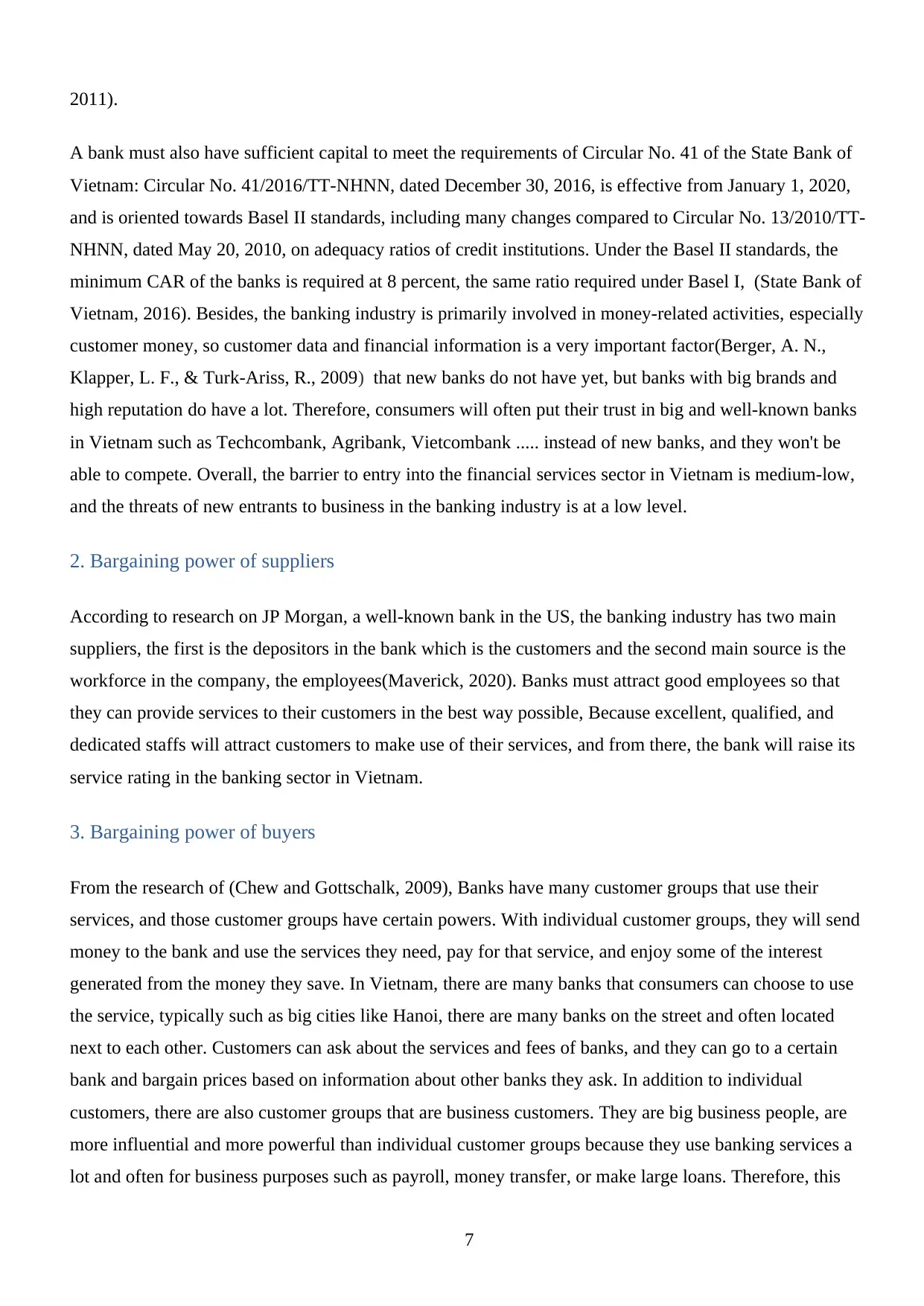
2011).
A bank must also have sufficient capital to meet the requirements of Circular No. 41 of the State Bank of
Vietnam: Circular No. 41/2016/TT-NHNN, dated December 30, 2016, is effective from January 1, 2020,
and is oriented towards Basel II standards, including many changes compared to Circular No. 13/2010/TT-
NHNN, dated May 20, 2010, on adequacy ratios of credit institutions. Under the Basel II standards, the
minimum CAR of the banks is required at 8 percent, the same ratio required under Basel I, (State Bank of
Vietnam, 2016). Besides, the banking industry is primarily involved in money-related activities, especially
customer money, so customer data and financial information is a very important factor(Berger, A. N.,
Klapper, L. F., & Turk-Ariss, R., 2009) that new banks do not have yet, but banks with big brands and
high reputation do have a lot. Therefore, consumers will often put their trust in big and well-known banks
in Vietnam such as Techcombank, Agribank, Vietcombank ..... instead of new banks, and they won't be
able to compete. Overall, the barrier to entry into the financial services sector in Vietnam is medium-low,
and the threats of new entrants to business in the banking industry is at a low level.
2. Bargaining power of suppliers
According to research on JP Morgan, a well-known bank in the US, the banking industry has two main
suppliers, the first is the depositors in the bank which is the customers and the second main source is the
workforce in the company, the employees(Maverick, 2020). Banks must attract good employees so that
they can provide services to their customers in the best way possible, Because excellent, qualified, and
dedicated staffs will attract customers to make use of their services, and from there, the bank will raise its
service rating in the banking sector in Vietnam.
3. Bargaining power of buyers
From the research of (Chew and Gottschalk, 2009), Banks have many customer groups that use their
services, and those customer groups have certain powers. With individual customer groups, they will send
money to the bank and use the services they need, pay for that service, and enjoy some of the interest
generated from the money they save. In Vietnam, there are many banks that consumers can choose to use
the service, typically such as big cities like Hanoi, there are many banks on the street and often located
next to each other. Customers can ask about the services and fees of banks, and they can go to a certain
bank and bargain prices based on information about other banks they ask. In addition to individual
customers, there are also customer groups that are business customers. They are big business people, are
more influential and more powerful than individual customer groups because they use banking services a
lot and often for business purposes such as payroll, money transfer, or make large loans. Therefore, this
7
A bank must also have sufficient capital to meet the requirements of Circular No. 41 of the State Bank of
Vietnam: Circular No. 41/2016/TT-NHNN, dated December 30, 2016, is effective from January 1, 2020,
and is oriented towards Basel II standards, including many changes compared to Circular No. 13/2010/TT-
NHNN, dated May 20, 2010, on adequacy ratios of credit institutions. Under the Basel II standards, the
minimum CAR of the banks is required at 8 percent, the same ratio required under Basel I, (State Bank of
Vietnam, 2016). Besides, the banking industry is primarily involved in money-related activities, especially
customer money, so customer data and financial information is a very important factor(Berger, A. N.,
Klapper, L. F., & Turk-Ariss, R., 2009) that new banks do not have yet, but banks with big brands and
high reputation do have a lot. Therefore, consumers will often put their trust in big and well-known banks
in Vietnam such as Techcombank, Agribank, Vietcombank ..... instead of new banks, and they won't be
able to compete. Overall, the barrier to entry into the financial services sector in Vietnam is medium-low,
and the threats of new entrants to business in the banking industry is at a low level.
2. Bargaining power of suppliers
According to research on JP Morgan, a well-known bank in the US, the banking industry has two main
suppliers, the first is the depositors in the bank which is the customers and the second main source is the
workforce in the company, the employees(Maverick, 2020). Banks must attract good employees so that
they can provide services to their customers in the best way possible, Because excellent, qualified, and
dedicated staffs will attract customers to make use of their services, and from there, the bank will raise its
service rating in the banking sector in Vietnam.
3. Bargaining power of buyers
From the research of (Chew and Gottschalk, 2009), Banks have many customer groups that use their
services, and those customer groups have certain powers. With individual customer groups, they will send
money to the bank and use the services they need, pay for that service, and enjoy some of the interest
generated from the money they save. In Vietnam, there are many banks that consumers can choose to use
the service, typically such as big cities like Hanoi, there are many banks on the street and often located
next to each other. Customers can ask about the services and fees of banks, and they can go to a certain
bank and bargain prices based on information about other banks they ask. In addition to individual
customers, there are also customer groups that are business customers. They are big business people, are
more influential and more powerful than individual customer groups because they use banking services a
lot and often for business purposes such as payroll, money transfer, or make large loans. Therefore, this
7
Paraphrase This Document
Need a fresh take? Get an instant paraphrase of this document with our AI Paraphraser
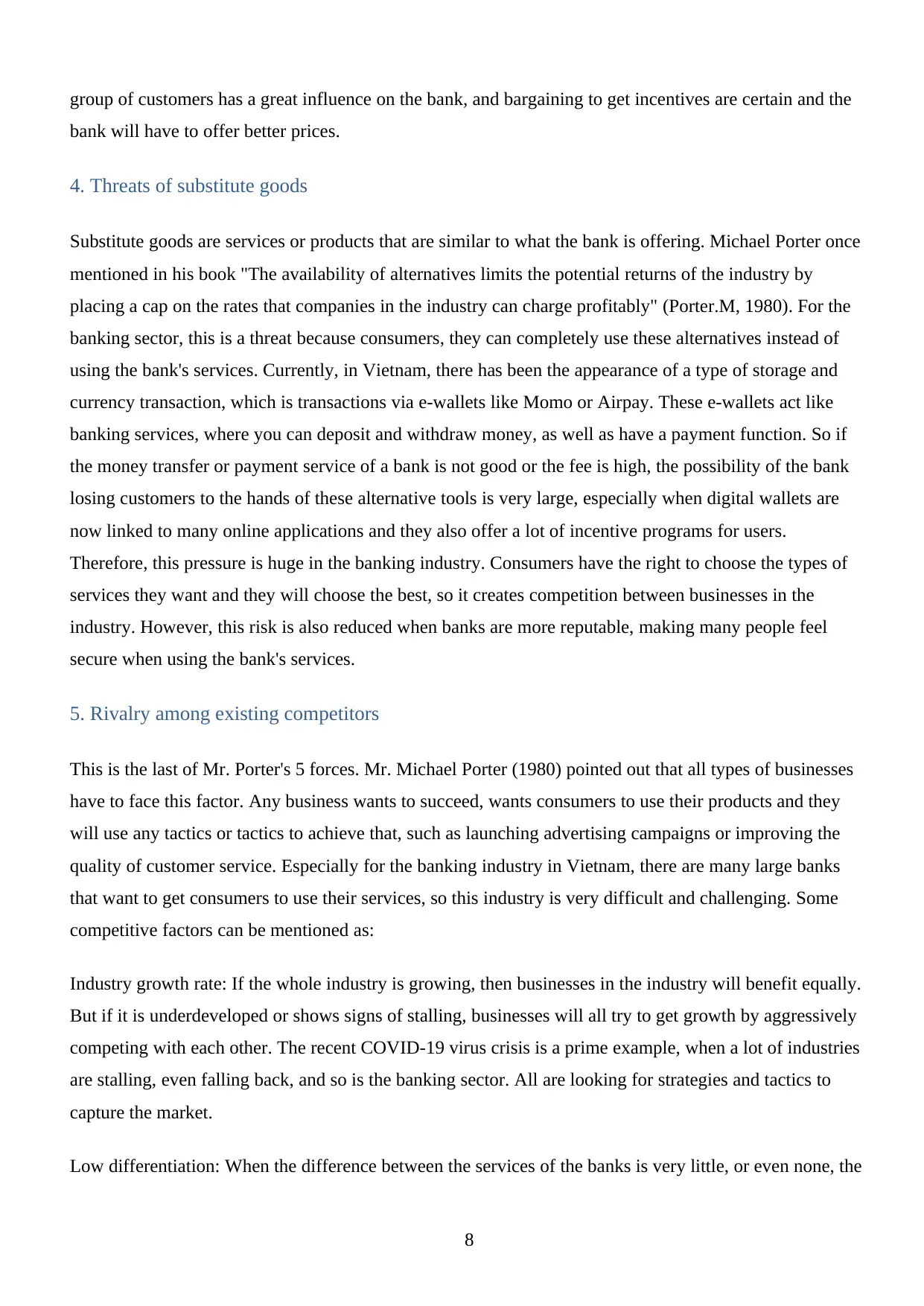
group of customers has a great influence on the bank, and bargaining to get incentives are certain and the
bank will have to offer better prices.
4. Threats of substitute goods
Substitute goods are services or products that are similar to what the bank is offering. Michael Porter once
mentioned in his book "The availability of alternatives limits the potential returns of the industry by
placing a cap on the rates that companies in the industry can charge profitably" (Porter.M, 1980). For the
banking sector, this is a threat because consumers, they can completely use these alternatives instead of
using the bank's services. Currently, in Vietnam, there has been the appearance of a type of storage and
currency transaction, which is transactions via e-wallets like Momo or Airpay. These e-wallets act like
banking services, where you can deposit and withdraw money, as well as have a payment function. So if
the money transfer or payment service of a bank is not good or the fee is high, the possibility of the bank
losing customers to the hands of these alternative tools is very large, especially when digital wallets are
now linked to many online applications and they also offer a lot of incentive programs for users.
Therefore, this pressure is huge in the banking industry. Consumers have the right to choose the types of
services they want and they will choose the best, so it creates competition between businesses in the
industry. However, this risk is also reduced when banks are more reputable, making many people feel
secure when using the bank's services.
5. Rivalry among existing competitors
This is the last of Mr. Porter's 5 forces. Mr. Michael Porter (1980) pointed out that all types of businesses
have to face this factor. Any business wants to succeed, wants consumers to use their products and they
will use any tactics or tactics to achieve that, such as launching advertising campaigns or improving the
quality of customer service. Especially for the banking industry in Vietnam, there are many large banks
that want to get consumers to use their services, so this industry is very difficult and challenging. Some
competitive factors can be mentioned as:
Industry growth rate: If the whole industry is growing, then businesses in the industry will benefit equally.
But if it is underdeveloped or shows signs of stalling, businesses will all try to get growth by aggressively
competing with each other. The recent COVID-19 virus crisis is a prime example, when a lot of industries
are stalling, even falling back, and so is the banking sector. All are looking for strategies and tactics to
capture the market.
Low differentiation: When the difference between the services of the banks is very little, or even none, the
8
bank will have to offer better prices.
4. Threats of substitute goods
Substitute goods are services or products that are similar to what the bank is offering. Michael Porter once
mentioned in his book "The availability of alternatives limits the potential returns of the industry by
placing a cap on the rates that companies in the industry can charge profitably" (Porter.M, 1980). For the
banking sector, this is a threat because consumers, they can completely use these alternatives instead of
using the bank's services. Currently, in Vietnam, there has been the appearance of a type of storage and
currency transaction, which is transactions via e-wallets like Momo or Airpay. These e-wallets act like
banking services, where you can deposit and withdraw money, as well as have a payment function. So if
the money transfer or payment service of a bank is not good or the fee is high, the possibility of the bank
losing customers to the hands of these alternative tools is very large, especially when digital wallets are
now linked to many online applications and they also offer a lot of incentive programs for users.
Therefore, this pressure is huge in the banking industry. Consumers have the right to choose the types of
services they want and they will choose the best, so it creates competition between businesses in the
industry. However, this risk is also reduced when banks are more reputable, making many people feel
secure when using the bank's services.
5. Rivalry among existing competitors
This is the last of Mr. Porter's 5 forces. Mr. Michael Porter (1980) pointed out that all types of businesses
have to face this factor. Any business wants to succeed, wants consumers to use their products and they
will use any tactics or tactics to achieve that, such as launching advertising campaigns or improving the
quality of customer service. Especially for the banking industry in Vietnam, there are many large banks
that want to get consumers to use their services, so this industry is very difficult and challenging. Some
competitive factors can be mentioned as:
Industry growth rate: If the whole industry is growing, then businesses in the industry will benefit equally.
But if it is underdeveloped or shows signs of stalling, businesses will all try to get growth by aggressively
competing with each other. The recent COVID-19 virus crisis is a prime example, when a lot of industries
are stalling, even falling back, and so is the banking sector. All are looking for strategies and tactics to
capture the market.
Low differentiation: When the difference between the services of the banks is very little, or even none, the
8
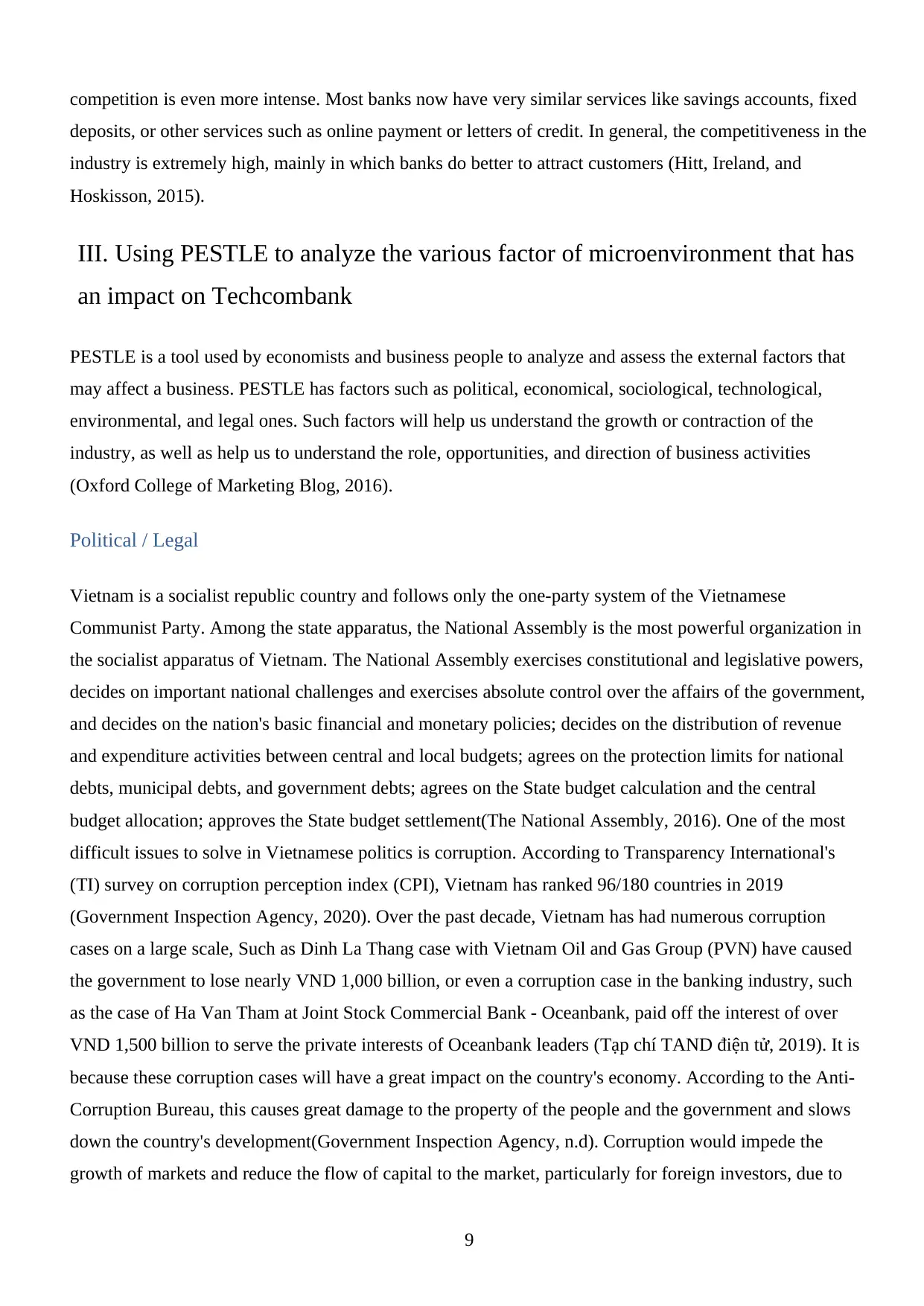
competition is even more intense. Most banks now have very similar services like savings accounts, fixed
deposits, or other services such as online payment or letters of credit. In general, the competitiveness in the
industry is extremely high, mainly in which banks do better to attract customers (Hitt, Ireland, and
Hoskisson, 2015).
III. Using PESTLE to analyze the various factor of microenvironment that has
an impact on Techcombank
PESTLE is a tool used by economists and business people to analyze and assess the external factors that
may affect a business. PESTLE has factors such as political, economical, sociological, technological,
environmental, and legal ones. Such factors will help us understand the growth or contraction of the
industry, as well as help us to understand the role, opportunities, and direction of business activities
(Oxford College of Marketing Blog, 2016).
Political / Legal
Vietnam is a socialist republic country and follows only the one-party system of the Vietnamese
Communist Party. Among the state apparatus, the National Assembly is the most powerful organization in
the socialist apparatus of Vietnam. The National Assembly exercises constitutional and legislative powers,
decides on important national challenges and exercises absolute control over the affairs of the government,
and decides on the nation's basic financial and monetary policies; decides on the distribution of revenue
and expenditure activities between central and local budgets; agrees on the protection limits for national
debts, municipal debts, and government debts; agrees on the State budget calculation and the central
budget allocation; approves the State budget settlement(The National Assembly, 2016). One of the most
difficult issues to solve in Vietnamese politics is corruption. According to Transparency International's
(TI) survey on corruption perception index (CPI), Vietnam has ranked 96/180 countries in 2019
(Government Inspection Agency, 2020). Over the past decade, Vietnam has had numerous corruption
cases on a large scale, Such as Dinh La Thang case with Vietnam Oil and Gas Group (PVN) have caused
the government to lose nearly VND 1,000 billion, or even a corruption case in the banking industry, such
as the case of Ha Van Tham at Joint Stock Commercial Bank - Oceanbank, paid off the interest of over
VND 1,500 billion to serve the private interests of Oceanbank leaders (Tạp chí TAND điện tử, 2019). It is
because these corruption cases will have a great impact on the country's economy. According to the Anti-
Corruption Bureau, this causes great damage to the property of the people and the government and slows
down the country's development(Government Inspection Agency, n.d). Corruption would impede the
growth of markets and reduce the flow of capital to the market, particularly for foreign investors, due to
9
deposits, or other services such as online payment or letters of credit. In general, the competitiveness in the
industry is extremely high, mainly in which banks do better to attract customers (Hitt, Ireland, and
Hoskisson, 2015).
III. Using PESTLE to analyze the various factor of microenvironment that has
an impact on Techcombank
PESTLE is a tool used by economists and business people to analyze and assess the external factors that
may affect a business. PESTLE has factors such as political, economical, sociological, technological,
environmental, and legal ones. Such factors will help us understand the growth or contraction of the
industry, as well as help us to understand the role, opportunities, and direction of business activities
(Oxford College of Marketing Blog, 2016).
Political / Legal
Vietnam is a socialist republic country and follows only the one-party system of the Vietnamese
Communist Party. Among the state apparatus, the National Assembly is the most powerful organization in
the socialist apparatus of Vietnam. The National Assembly exercises constitutional and legislative powers,
decides on important national challenges and exercises absolute control over the affairs of the government,
and decides on the nation's basic financial and monetary policies; decides on the distribution of revenue
and expenditure activities between central and local budgets; agrees on the protection limits for national
debts, municipal debts, and government debts; agrees on the State budget calculation and the central
budget allocation; approves the State budget settlement(The National Assembly, 2016). One of the most
difficult issues to solve in Vietnamese politics is corruption. According to Transparency International's
(TI) survey on corruption perception index (CPI), Vietnam has ranked 96/180 countries in 2019
(Government Inspection Agency, 2020). Over the past decade, Vietnam has had numerous corruption
cases on a large scale, Such as Dinh La Thang case with Vietnam Oil and Gas Group (PVN) have caused
the government to lose nearly VND 1,000 billion, or even a corruption case in the banking industry, such
as the case of Ha Van Tham at Joint Stock Commercial Bank - Oceanbank, paid off the interest of over
VND 1,500 billion to serve the private interests of Oceanbank leaders (Tạp chí TAND điện tử, 2019). It is
because these corruption cases will have a great impact on the country's economy. According to the Anti-
Corruption Bureau, this causes great damage to the property of the people and the government and slows
down the country's development(Government Inspection Agency, n.d). Corruption would impede the
growth of markets and reduce the flow of capital to the market, particularly for foreign investors, due to
9
⊘ This is a preview!⊘
Do you want full access?
Subscribe today to unlock all pages.

Trusted by 1+ million students worldwide
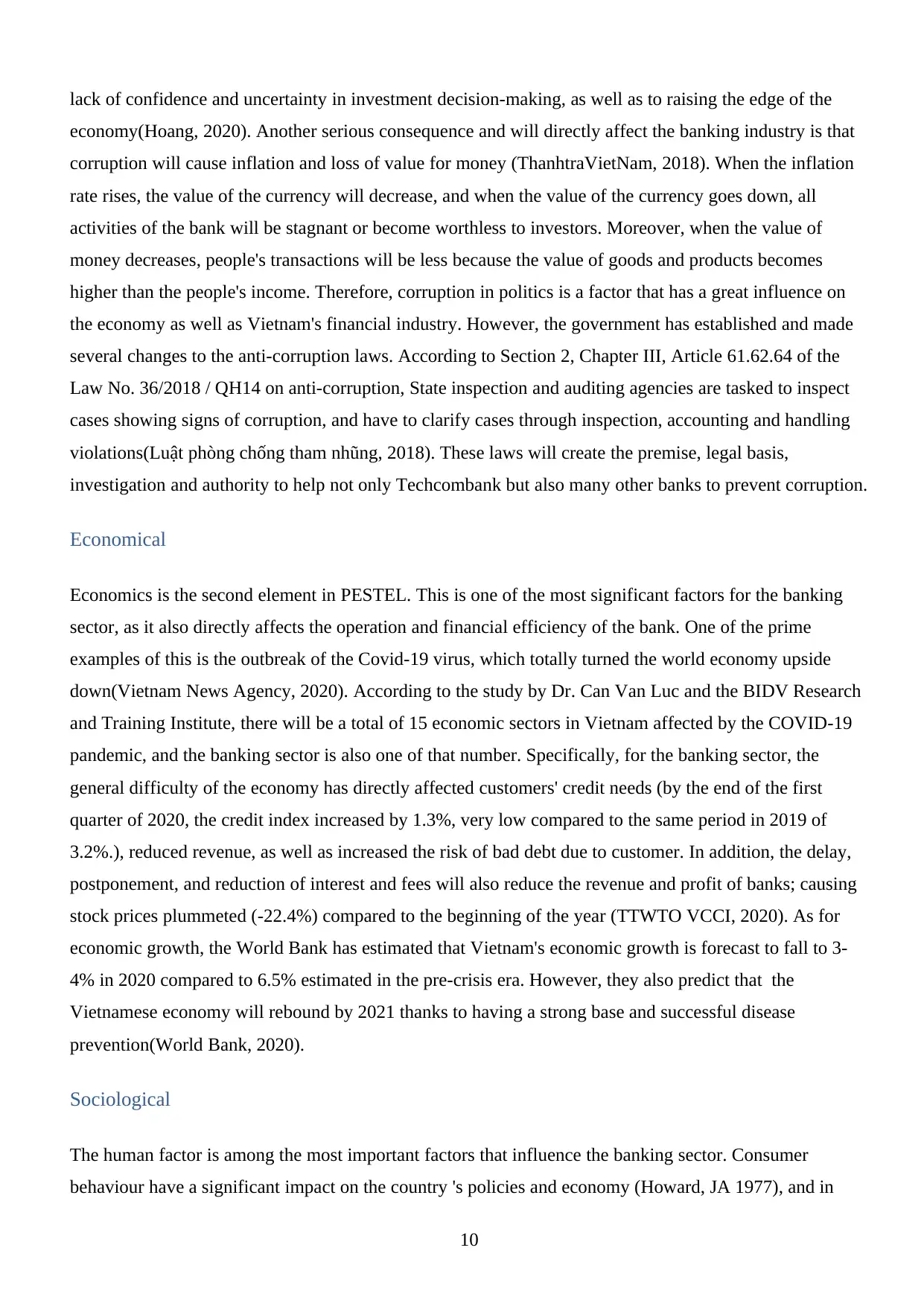
lack of confidence and uncertainty in investment decision-making, as well as to raising the edge of the
economy(Hoang, 2020). Another serious consequence and will directly affect the banking industry is that
corruption will cause inflation and loss of value for money (ThanhtraVietNam, 2018). When the inflation
rate rises, the value of the currency will decrease, and when the value of the currency goes down, all
activities of the bank will be stagnant or become worthless to investors. Moreover, when the value of
money decreases, people's transactions will be less because the value of goods and products becomes
higher than the people's income. Therefore, corruption in politics is a factor that has a great influence on
the economy as well as Vietnam's financial industry. However, the government has established and made
several changes to the anti-corruption laws. According to Section 2, Chapter III, Article 61.62.64 of the
Law No. 36/2018 / QH14 on anti-corruption, State inspection and auditing agencies are tasked to inspect
cases showing signs of corruption, and have to clarify cases through inspection, accounting and handling
violations(Luật phòng chống tham nhũng, 2018). These laws will create the premise, legal basis,
investigation and authority to help not only Techcombank but also many other banks to prevent corruption.
Economical
Economics is the second element in PESTEL. This is one of the most significant factors for the banking
sector, as it also directly affects the operation and financial efficiency of the bank. One of the prime
examples of this is the outbreak of the Covid-19 virus, which totally turned the world economy upside
down(Vietnam News Agency, 2020). According to the study by Dr. Can Van Luc and the BIDV Research
and Training Institute, there will be a total of 15 economic sectors in Vietnam affected by the COVID-19
pandemic, and the banking sector is also one of that number. Specifically, for the banking sector, the
general difficulty of the economy has directly affected customers' credit needs (by the end of the first
quarter of 2020, the credit index increased by 1.3%, very low compared to the same period in 2019 of
3.2%.), reduced revenue, as well as increased the risk of bad debt due to customer. In addition, the delay,
postponement, and reduction of interest and fees will also reduce the revenue and profit of banks; causing
stock prices plummeted (-22.4%) compared to the beginning of the year (TTWTO VCCI, 2020). As for
economic growth, the World Bank has estimated that Vietnam's economic growth is forecast to fall to 3-
4% in 2020 compared to 6.5% estimated in the pre-crisis era. However, they also predict that the
Vietnamese economy will rebound by 2021 thanks to having a strong base and successful disease
prevention(World Bank, 2020).
Sociological
The human factor is among the most important factors that influence the banking sector. Consumer
behaviour have a significant impact on the country 's policies and economy (Howard, JA 1977), and in
10
economy(Hoang, 2020). Another serious consequence and will directly affect the banking industry is that
corruption will cause inflation and loss of value for money (ThanhtraVietNam, 2018). When the inflation
rate rises, the value of the currency will decrease, and when the value of the currency goes down, all
activities of the bank will be stagnant or become worthless to investors. Moreover, when the value of
money decreases, people's transactions will be less because the value of goods and products becomes
higher than the people's income. Therefore, corruption in politics is a factor that has a great influence on
the economy as well as Vietnam's financial industry. However, the government has established and made
several changes to the anti-corruption laws. According to Section 2, Chapter III, Article 61.62.64 of the
Law No. 36/2018 / QH14 on anti-corruption, State inspection and auditing agencies are tasked to inspect
cases showing signs of corruption, and have to clarify cases through inspection, accounting and handling
violations(Luật phòng chống tham nhũng, 2018). These laws will create the premise, legal basis,
investigation and authority to help not only Techcombank but also many other banks to prevent corruption.
Economical
Economics is the second element in PESTEL. This is one of the most significant factors for the banking
sector, as it also directly affects the operation and financial efficiency of the bank. One of the prime
examples of this is the outbreak of the Covid-19 virus, which totally turned the world economy upside
down(Vietnam News Agency, 2020). According to the study by Dr. Can Van Luc and the BIDV Research
and Training Institute, there will be a total of 15 economic sectors in Vietnam affected by the COVID-19
pandemic, and the banking sector is also one of that number. Specifically, for the banking sector, the
general difficulty of the economy has directly affected customers' credit needs (by the end of the first
quarter of 2020, the credit index increased by 1.3%, very low compared to the same period in 2019 of
3.2%.), reduced revenue, as well as increased the risk of bad debt due to customer. In addition, the delay,
postponement, and reduction of interest and fees will also reduce the revenue and profit of banks; causing
stock prices plummeted (-22.4%) compared to the beginning of the year (TTWTO VCCI, 2020). As for
economic growth, the World Bank has estimated that Vietnam's economic growth is forecast to fall to 3-
4% in 2020 compared to 6.5% estimated in the pre-crisis era. However, they also predict that the
Vietnamese economy will rebound by 2021 thanks to having a strong base and successful disease
prevention(World Bank, 2020).
Sociological
The human factor is among the most important factors that influence the banking sector. Consumer
behaviour have a significant impact on the country 's policies and economy (Howard, JA 1977), and in
10
Paraphrase This Document
Need a fresh take? Get an instant paraphrase of this document with our AI Paraphraser
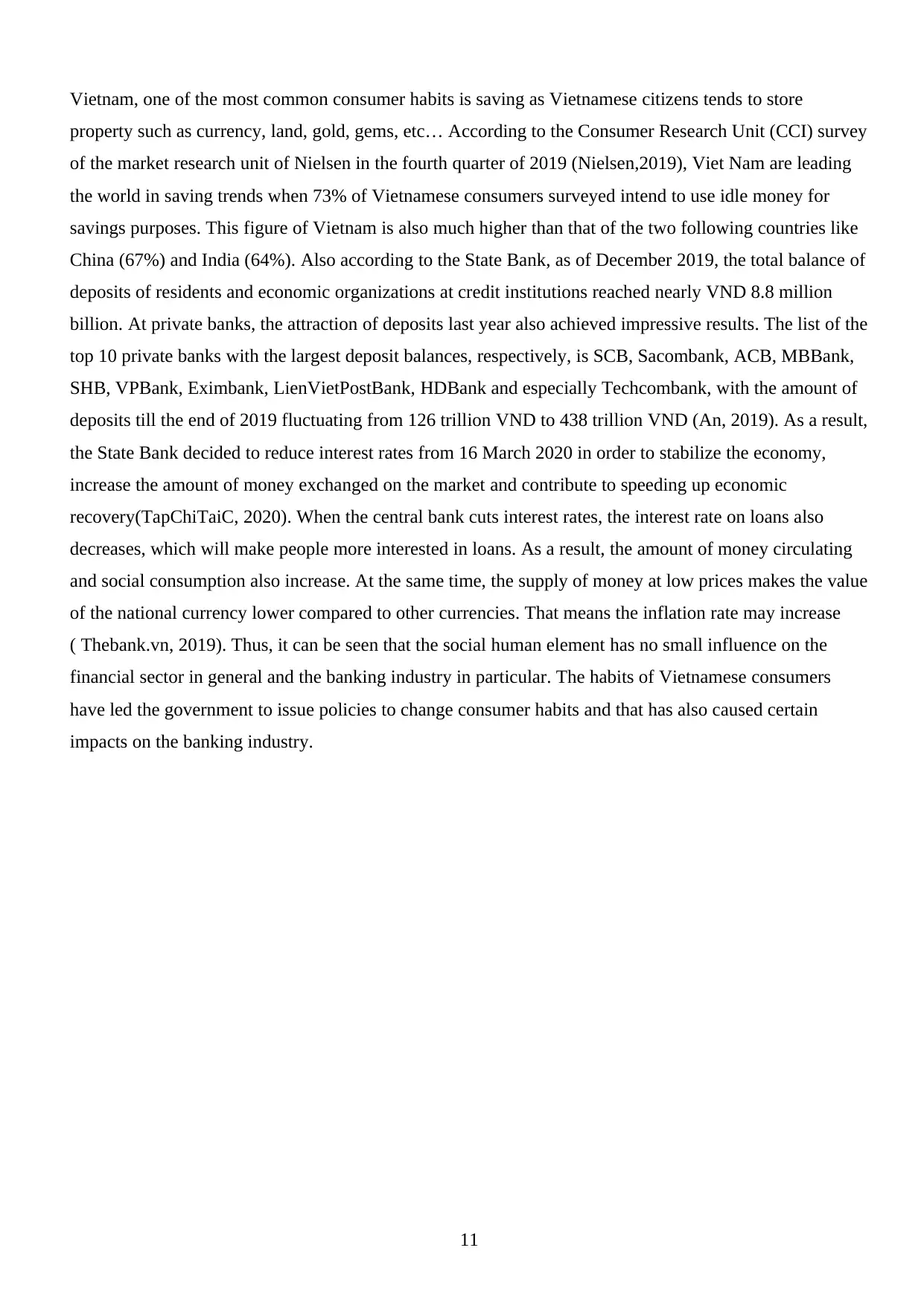
Vietnam, one of the most common consumer habits is saving as Vietnamese citizens tends to store
property such as currency, land, gold, gems, etc… According to the Consumer Research Unit (CCI) survey
of the market research unit of Nielsen in the fourth quarter of 2019 (Nielsen,2019), Viet Nam are leading
the world in saving trends when 73% of Vietnamese consumers surveyed intend to use idle money for
savings purposes. This figure of Vietnam is also much higher than that of the two following countries like
China (67%) and India (64%). Also according to the State Bank, as of December 2019, the total balance of
deposits of residents and economic organizations at credit institutions reached nearly VND 8.8 million
billion. At private banks, the attraction of deposits last year also achieved impressive results. The list of the
top 10 private banks with the largest deposit balances, respectively, is SCB, Sacombank, ACB, MBBank,
SHB, VPBank, Eximbank, LienVietPostBank, HDBank and especially Techcombank, with the amount of
deposits till the end of 2019 fluctuating from 126 trillion VND to 438 trillion VND (An, 2019). As a result,
the State Bank decided to reduce interest rates from 16 March 2020 in order to stabilize the economy,
increase the amount of money exchanged on the market and contribute to speeding up economic
recovery(TapChiTaiC, 2020). When the central bank cuts interest rates, the interest rate on loans also
decreases, which will make people more interested in loans. As a result, the amount of money circulating
and social consumption also increase. At the same time, the supply of money at low prices makes the value
of the national currency lower compared to other currencies. That means the inflation rate may increase
( Thebank.vn, 2019). Thus, it can be seen that the social human element has no small influence on the
financial sector in general and the banking industry in particular. The habits of Vietnamese consumers
have led the government to issue policies to change consumer habits and that has also caused certain
impacts on the banking industry.
11
property such as currency, land, gold, gems, etc… According to the Consumer Research Unit (CCI) survey
of the market research unit of Nielsen in the fourth quarter of 2019 (Nielsen,2019), Viet Nam are leading
the world in saving trends when 73% of Vietnamese consumers surveyed intend to use idle money for
savings purposes. This figure of Vietnam is also much higher than that of the two following countries like
China (67%) and India (64%). Also according to the State Bank, as of December 2019, the total balance of
deposits of residents and economic organizations at credit institutions reached nearly VND 8.8 million
billion. At private banks, the attraction of deposits last year also achieved impressive results. The list of the
top 10 private banks with the largest deposit balances, respectively, is SCB, Sacombank, ACB, MBBank,
SHB, VPBank, Eximbank, LienVietPostBank, HDBank and especially Techcombank, with the amount of
deposits till the end of 2019 fluctuating from 126 trillion VND to 438 trillion VND (An, 2019). As a result,
the State Bank decided to reduce interest rates from 16 March 2020 in order to stabilize the economy,
increase the amount of money exchanged on the market and contribute to speeding up economic
recovery(TapChiTaiC, 2020). When the central bank cuts interest rates, the interest rate on loans also
decreases, which will make people more interested in loans. As a result, the amount of money circulating
and social consumption also increase. At the same time, the supply of money at low prices makes the value
of the national currency lower compared to other currencies. That means the inflation rate may increase
( Thebank.vn, 2019). Thus, it can be seen that the social human element has no small influence on the
financial sector in general and the banking industry in particular. The habits of Vietnamese consumers
have led the government to issue policies to change consumer habits and that has also caused certain
impacts on the banking industry.
11
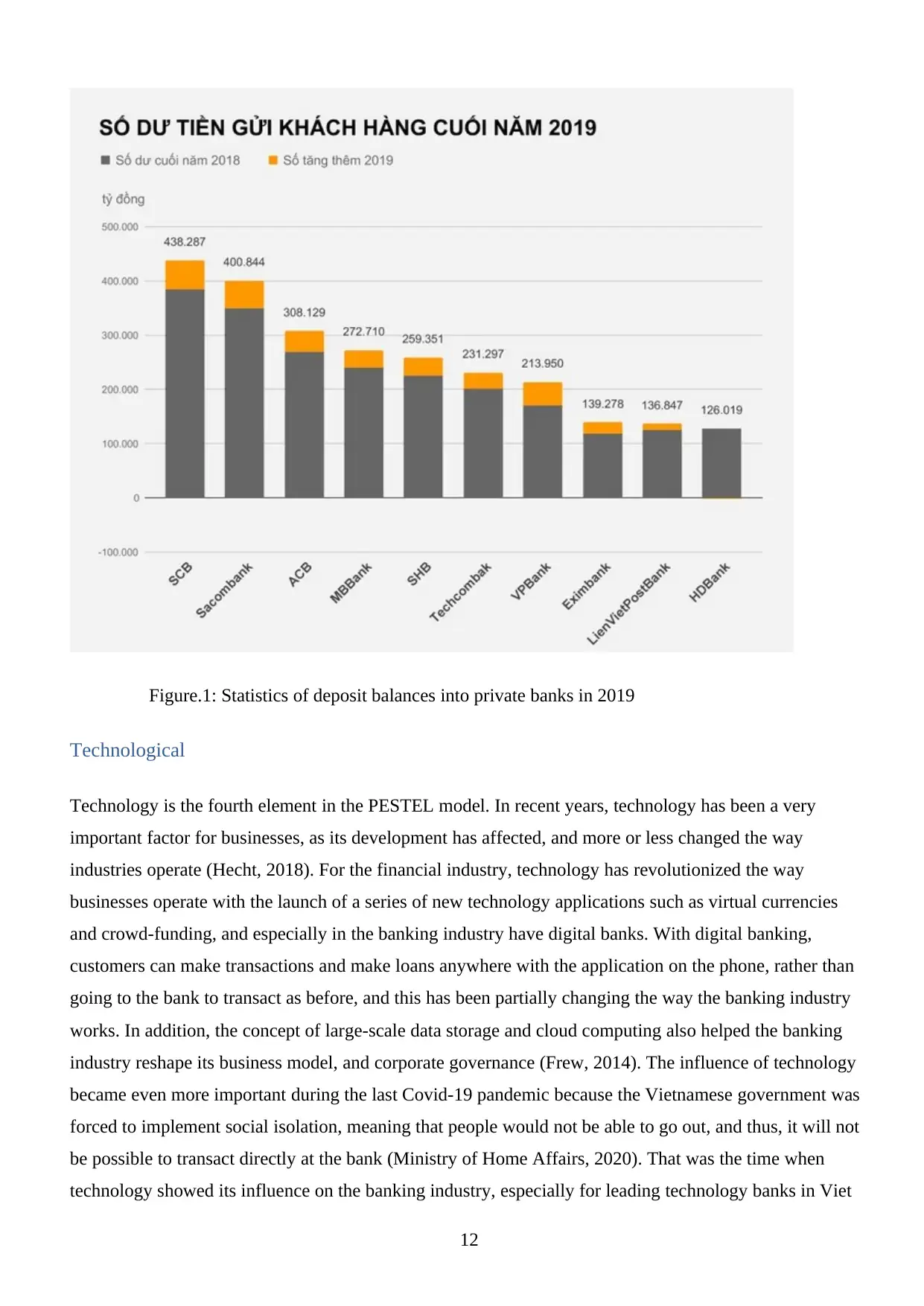
Figure.1: Statistics of deposit balances into private banks in 2019
Technological
Technology is the fourth element in the PESTEL model. In recent years, technology has been a very
important factor for businesses, as its development has affected, and more or less changed the way
industries operate (Hecht, 2018). For the financial industry, technology has revolutionized the way
businesses operate with the launch of a series of new technology applications such as virtual currencies
and crowd-funding, and especially in the banking industry have digital banks. With digital banking,
customers can make transactions and make loans anywhere with the application on the phone, rather than
going to the bank to transact as before, and this has been partially changing the way the banking industry
works. In addition, the concept of large-scale data storage and cloud computing also helped the banking
industry reshape its business model, and corporate governance (Frew, 2014). The influence of technology
became even more important during the last Covid-19 pandemic because the Vietnamese government was
forced to implement social isolation, meaning that people would not be able to go out, and thus, it will not
be possible to transact directly at the bank (Ministry of Home Affairs, 2020). That was the time when
technology showed its influence on the banking industry, especially for leading technology banks in Viet
12
Technological
Technology is the fourth element in the PESTEL model. In recent years, technology has been a very
important factor for businesses, as its development has affected, and more or less changed the way
industries operate (Hecht, 2018). For the financial industry, technology has revolutionized the way
businesses operate with the launch of a series of new technology applications such as virtual currencies
and crowd-funding, and especially in the banking industry have digital banks. With digital banking,
customers can make transactions and make loans anywhere with the application on the phone, rather than
going to the bank to transact as before, and this has been partially changing the way the banking industry
works. In addition, the concept of large-scale data storage and cloud computing also helped the banking
industry reshape its business model, and corporate governance (Frew, 2014). The influence of technology
became even more important during the last Covid-19 pandemic because the Vietnamese government was
forced to implement social isolation, meaning that people would not be able to go out, and thus, it will not
be possible to transact directly at the bank (Ministry of Home Affairs, 2020). That was the time when
technology showed its influence on the banking industry, especially for leading technology banks in Viet
12
⊘ This is a preview!⊘
Do you want full access?
Subscribe today to unlock all pages.

Trusted by 1+ million students worldwide
1 out of 26
Related Documents
Your All-in-One AI-Powered Toolkit for Academic Success.
+13062052269
info@desklib.com
Available 24*7 on WhatsApp / Email
![[object Object]](/_next/static/media/star-bottom.7253800d.svg)
Unlock your academic potential
Copyright © 2020–2025 A2Z Services. All Rights Reserved. Developed and managed by ZUCOL.





